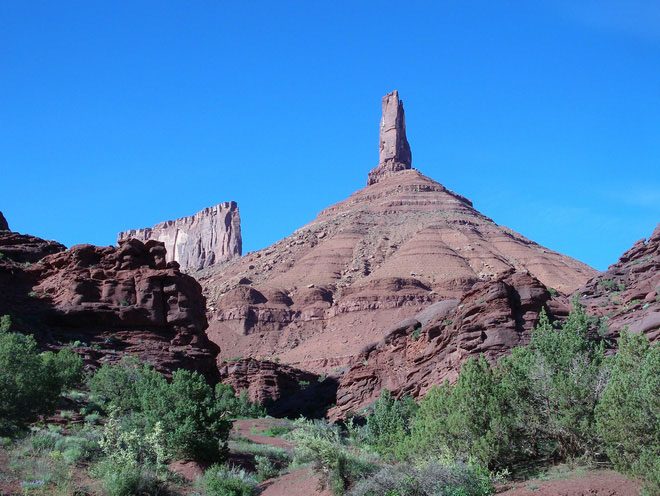In the United States, there is a 120-meter-high rock column that 'swayed' when it hit an earthquake and high winds
Scientists at the University of Utah became the first team to publish a seismic activity measurement report on a strange rock column located in a natural park near the town of Moab, so special that there was a proper name: Castleton Tower.
This rock vibrates at two different frequencies, which means it can stand up to a mild or medium earthquake. How the team of Utah scientists studied the Castleton Tower could also apply to other natural rock structures, to determine what they would look like when seismic activity takes place.

The rock vibrated at two different frequencies, which meant it could stand up to a mild earthquake.
' We still consider areas of particular terrain to be an obvious part of the landscape, but in fact, they are constantly moving and evolving, ' said study co-author Riley Finnegan. ' Because nothing is completely static, and there is always energy flowing in the soil, we will have a source that causes this rock structure to vibrate continuously .'
The team also considered 'digital transformation' of their research: they had a website dedicated to recording seismic activity and natural vibrations in the Utah area. This study site is special because the red rocks are about 16km from the town of Moab. These rocks can be bent, pushed and shaken due to the effects of strong winds, earthquakes, pressure caused by temperature differences inside and outside the rock, even, initial observations. Given that local vehicles can also cause vibrations that affect rocks in the area. If the vibration frequency was within a certain range, the energy affecting the ancient stones would be multiplied many times.
By understanding the factors that cause vibrations, one can predict what will happen to the slab in specific cases. It takes a lot of effort to study artificial houses, but forgets that nature can provide valuable lessons in design and material science: researching the Castleton Tower will be able to give us a tower. hundred floors steady before the wrath of nature.

These rocks can be bent, pushed and vibrated due to the impact of strong winds, earthquakes .
The topography of this area is the biggest obstacle preventing scientists from measuring seismic conditions. The two main reasons are that local authorities restrict access to the area to preserve the area, and the area itself is too difficult to climb in to place sensors. All of these difficulties have made the new research results even more valuable: until now, science has witnessed the vibrations emanating from the 120-meter-high Castleton Tower.
' A few years ago, these measurements did not exist ,' co-author Jeff Moore and chief researcher, told Ars Technica. ' Each number collected is something new .'
Moore, Finnegan and colleagues collected data from two veteran mountain climbers. They were able to climb up to the high tower and put sensors on key points: one at the foot of the Tower and the other at the top of the Tower. The two climbers sat by the measuring device for 3 hours before returning to the study team.

Castleton Tower viewed from above.
From previous experiments, the Utah team of scientists knew that large blocks of natural architecture, such as the Castleton Tower, could vibrate at a very different frequency from small stone pillars, no different from We distinguish the sound coming from two thick and thin guitar strings. Analyzing the frequency emitted from the Castleton Tower, they found the two peaks of 0.8 and 1 Hz, indicating that this tall structure would be very sensitive to earthquakes, which rarely occur in the Utah area.
Small vibrations, such as vehicles and shocks from construction sites, can hardly make Castleton Tower 'flutter'. However, according to researcher Moore: ' Although the impact caused by humans is very small, our research shows that human activities have increased the rate of erosion of this large rock structure '.
The research done on Castleton Tower can be applied to other natural stone structures, just by changing the height, thickness of the rock and the structural material. The 'common formula' will help science track the integrity of any natural structure.
- 7.6-magnitude earthquake in New Caledonia, a tsunami warning of 3m high
- 4.7 Richter earthquake shook northern China
- The heat caused 13 deaths in the United States
- Terrifying warnings about imminent earthquakes
- Big storm swept the Midwestern United States
- HOT! The 2-meter tsunami hit Indonesia city after the earthquake
- Volcanic eruption column of 10km high
- Blood glucose meter, health care therapy
- Tornadoes swept across the southern United States, 37 people died
- Tsunami risk in the West Coast of the United States
- Poisonous open pit earthquake in the United States
- Japanese radiation detection off the west coast of the United States
 'Fine laughs' - Scary and painful torture in ancient times
'Fine laughs' - Scary and painful torture in ancient times The sequence of numbers 142857 of the Egyptian pyramids is known as the strangest number in the world - Why?
The sequence of numbers 142857 of the Egyptian pyramids is known as the strangest number in the world - Why? History of the iron
History of the iron What is alum?
What is alum?